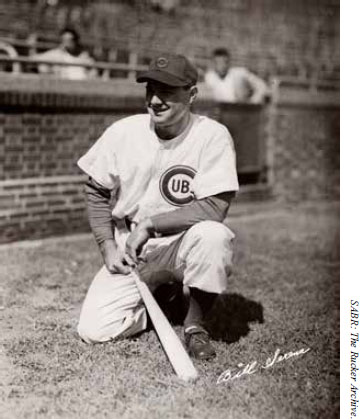Mr. September: Bill Serena in 1947
This article was written by Will Christensen
This article was published in When Minor League Baseball Almost Went Bust: 1946-1963
Bill Serena. (SABR-Rucker-Archive)
It can’t be said with absolute certainty, but it would seem almost certain that no one in the history of professional baseball had a better postseason than Bill Serena had in 1947.
Actually, no player on any level probably had a better 1947, relatively speaking, than Serena.
That year, Serena, in his second year of pro ball, had one of the greatest seasons of any minor leaguer ever. After a solid rookie season in Class-B ball in 1946, Serena had a brief tryout in 1947 with the Dallas Rebels in the Texas League before being shipped to Lubbock in the Class-C West Texas-New Mexico League.1
Yes, the WTNM is a legendary pinball league, but no one lit up the table that year quite like Serena. When the dust settled at the end of the year, he had a .374 batting average with 140 walks (a .514 on-base percentage). He had 109 extra-base hits, including 57 home runs (an .832 slugging average). He drove in 190 runs and scored 183. The extra-base hits, homers, runs, RBIs, and slugging average led the league. It’s estimated that Serena created 197 runs in his 137 games.
That’s not bad for a first basemen, except that Serena was a shortstop, not a good one but one who had a fielding percentage above league average.2 Even still … a shortstop. The only shortstop who ever hit more home runs in a season than Serena did—Tony Lazzeri in 1925—needed 60 more games to hit just three more.3
With Serena leading the way, the Lubbock Hubbers fashioned a sterling 99-41 record, behind the league’s leading offense (1,247 runs) while also allowing the fewest runs in the league (794). They took first place in a stroll, 14 games ahead of the runner-up Gold Sox of Amarillo.
Serena had a huge series in the semifinals, which started September 9:4
He homered in Games Two, Three (twice), and Four as Lubbock routed fourth-place Lamesa in four straight, outscoring the Lobos 56-16.
The championship series against Amarillo wasn’t quite as good:
That Serena underperformed might explain why it took six games for the Hubbers to dispense with the Gold Sox. Heck, Serena even took an oh-fer in the first game!5
Serena started slow, l-for-8 through the first two games, before having a five-hit Game Three that included three doubles and a homer.6 But it was Game Five when he really made his mark. With the Hubbers one out away from falling into a 3-2 hole, Serena hammered a homer to right to tie the game at 7-7.7
Then he drilled a two-run dinger as part of a nine-run 11th inning that salted away the game.8 (He also homered in the Game Six clincher as well as in Game Two—he homered in all four of the Hubbers’ wins.)
Now West Texas-New Mexico League champion, the Hubbers turned to what was known as the Class-C Championship of Texas, or the Little Dixie Series, against Kilgore, the champion of the Class-C Lone Star League. Serena did all right:
The Hubbers won in five games (ending the season on September 30), and, again, Serena homered in all four of his team’s victories.9 His biggest game was the first one, when he went 3-for-5 and drove in six runs to pace his team to a 14-1 win.10
When you put it all together, this is what Bill Serena did in the 1947 postseason:
![]()
It turns out that as good as he was during the regular season, Serena was even better during the postseason—against the best opposition.
To give you some perspective, the major-league record for home runs in a single postseason is 10 by Randy Arozarena, in 20 games in 2020. Further perspective: Just add a zero to the end of each above number to see what a full season of this sort of performance would look like. Sure, the 40 walks aren’t much, but I think most seamheads could live with the 130 homers.
Other players have put up better slash percentages over a shorter postseason, but it seems doubtful anyone has had that brilliant a performance over such a sustained period when it counted the most. (It wasn’t perfect; Serena made eight errors to fashion a .905 fielding percentage during the postseason, and his error rate in the Class-C title series was brutal, although it didn’t seem to cost his team much overall.)11 Overall, Serena was a pretty good player. He never really had a bad year in the minors—finishing with 182 home runs in seven seasons—and he did all right in five-plus seasons in the majors.
But he never came close to scaling the great heights he achieved in 1947.
WILL CHRISTENSEN is a former journalist, avid researcher, and certified minor-league baseball nut. He has been a member of SABR since 1986 and has been interested in minor-league baseball most of the time since then. His first game to watch was the Columbus Jets during the team’s final season in 1970.
Acknowledgments
This article was edited by Thomas Rathkamp and fact-checked by Tony Escobedo.
Notes
1 “Rebs Send Five Men to Lower Loops,” Dallas Morning News, April 23, 1947: 5-
2 The 1948 Sporting News Baseball Guide carried fielding averages for West Texas-New Mexico League players who played at least 10 games at shortstop. Shortstops who played at least 10 games fielded .902; Serena fielded .911.
3 Lazzeri hit 60 homers with the Salt Lake City Bees in 197 games. Alex Rodriguez hit 57 homers with the Texas Rangers in 2002, the major-league record for a shortstop.
4 Bill Chick, “Hinrichs Hurls Three-Hitter as Hubbers Win First Series Tilt,” Lubbock (Texas’) Morning Avalanche, September 10, 1947: 8.
5 Harry Gilstrap, “Lonergan’s Four-Hitter Whitewashes Hubbers, 7-0,” Amarillo Daily News, September 17, 1947: 4. Serena would get his revenge later in the series.
6 Bill Chick, “Hubbers Batter Gold Sox 21 to 11, to Go One Ahead in Final Playoff Señes,’“ Lubbock Morning Avalanche, September Sept. 19, 1947: 10.
7 Frank A. Godsoe Jr., “Hubbers Rout Sox, 16-7,” Amarillo Sunday News-Globe, September 21, 1947: 15.
8 Godsoe, “Hubbers Rout Sox, 16-7.” Both homers were off Lonergan, who had blanked Lubbock and gave Serena his only oh-fer of the postseason four days earlier.
9 “Hubbers Drub Kilgore, 8 to 1, in Finale,” Lubbock Morning Avalanche, October 1, 1947: 7. The subhead noted Serena’s 70th homer of the season, including 57 in the regular season and 13 in the postseason.
10 Choc Hutcheson, “Heavy Hitting and Stingy Pitching Give Hubs Victory,” Lubbock Morning Avalanche, September 27, 1947: 8.
11 “Hubbers Are Humbled by Kilgore Drillers, 10 to 2, in Fourth Game of Class C Series,” Lubbock Morning Avalanche, September 30, 1947: 8. In the series against Kilgore, Serena made six errors in 35 chances, for an .829 fielding percentage. Nevertheless, four of the errors came during Lubbock victories.


